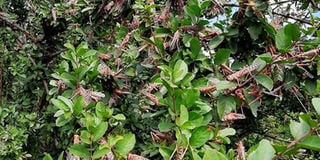Locusts now in Isiolo County

Some of the desert locusts which have invaded Gurar in Wajir North. The insects have been spotted in Meru and Isiolo. PHOTO | FILE | NATION MEDIA GROUP
What you need to know:
- Residents panic even as government officials say there's no cause for alarm.
Desert locusts that have ravaged north-eastern Kenya have made their way to Isiolo county even as local government officials downplayed their threat.
More swarms of the locusts have invaded Garbatulla and Merti areas in Isiolo.
On Tuesday evening, residents of Ndumuru in Igembe North, Meru County had also reported spotting several colonies of the destructive pests, but Agriculture Executive Carol Mutiga later said that the insects sighted were green hoppers, not locusts.
Ndumuru Chief Romano Muchiri said the insects, which are in nymph (wingless) stage, had been spotted in several groups feeding on shrubs.
Igembe North Deputy County Commissioner Charles Langat said government officials were monitoring the situation, adding that there was no cause for alarm.
In Isiolo, County Commissioner Narman Shambi said the swarms of locusts had covered up to 3,000 square kilometres of land in Garbatulla and Merti.
The invasion of locusts comes five days after Meru Jubilee Party chairman Joseph Muturia warned that the pests would soon reach the county from Wajir if not contained on time.
Mr Muturia called on the government to pump in more resources into fighting the locusts that have ravaged the north-eastern region to avert famine.
Mr Muturia, who says he witnessed a locust invasion in Meru in 1948, accused the government of knee-jerk reactions to disasters.
“Based on my experience, if these locusts spread to Meru and other areas where people depend on food and cash crops, it will be a major disaster. It seems those in government have never experienced locust invasions and their impact. The 1948 invasion led to a bad famine,” Mr Muturia said.
He called on the government to work closely with the Food and Agriculture Organisation’s (FAO) Desert Locust Control Committee to ensure the situation is contained.
Editor's Note: The story has been updated to reflect the current situation in Meru County.





